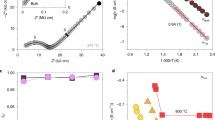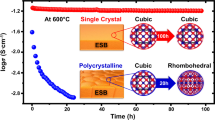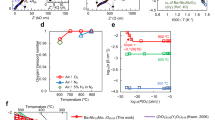Abstract
Reducing the operating temperature in the 500–750 °C range is needed for widespread use of solid oxide fuel cells (SOFCs). Proton-conducting oxides are gaining wide interest as electrolyte materials for this aim. We report the fabrication of BaZr0.8Y0.2O3−δ (BZY) proton-conducting electrolyte thin films by pulsed laser deposition on different single-crystalline substrates. Highly textured, epitaxially oriented BZY films were obtained on (100)-oriented MgO substrates, showing the largest proton conductivity ever reported for BZY samples, being 0.11 S cm−1 at 500 °C. The excellent crystalline quality of BZY films allowed for the first time the experimental measurement of the large BZY bulk conductivity above 300 °C, expected in the absence of blocking grain boundaries. The measured proton conductivity is also significantly larger than the conductivity values of oxygen-ion conductors in the same temperature range, opening new potential for the development of miniaturized SOFCs for portable power supply.
This is a preview of subscription content, access via your institution
Access options
Subscribe to this journal
Receive 12 print issues and online access
$259.00 per year
only $21.58 per issue
Buy this article
- Purchase on Springer Link
- Instant access to full article PDF
Prices may be subject to local taxes which are calculated during checkout





Similar content being viewed by others
References
Boudghene Stambouli, A. & Traversa, E. Solid oxide fuel cells (SOFCs): A review of an environmentally clean and efficient source of energy. Renew. Sustain. Energy Rev. 6, 433–455 (2002).
Brett, D. J. L., Atkinson, A., Brandon, N. P. & Skinner, S. J. Intermediate temperature solid oxide fuel cells. Chem. Soc. Rev. 37, 1568–1578 (2008).
Kendall, K. & Palin, M. A small solid oxide fuel cell demonstrator for microelectronic application. J. Power Sources 71, 268–270 (1998).
Perednis, D. & Gauckler, L. J. Solid oxide fuel cells with electrolytes prepared via spray pyrolysis. Solid State Ion. 166, 229–239 (2004).
De Souza, S., Visco, S. J. & De Jonghe, L. C. Thin-film solid oxide fuel cell with high performance at low temperature. Solid State Ion. 98, 57–61 (1997).
Beckel, D. J. et al. Thin films for micro solid oxide fuel cells. J. Power Sources 173, 325–345 (2007).
Steele, B. C. H. & Heinzel, A. Materials for fuel-cell technologies. Nature 414, 345–352 (2001).
Kreuer, K. D. Proton-conducting oxides. Annu. Rev. Mater. Res. 33, 333–359 (2003).
Bonanos, N. Transport properties and conduction mechanism in high-temperature protonic conductors. Solid State Ion. 53–56, 967–974 (1992).
Iwahara, H., Asakura, Y., Katahira, K. & Tanaka, M. Prospect of hydrogen technology using proton-conducting ceramics. Solid State Ion. 168, 299–310 (2004).
Ma, G., Shimura, T. & Iwahara, H. Ionic conduction and nonstoichiometry in BaxCe0.9Y0.1O3−α . Solid State Ion. 110, 103–110 (1998).
Zakowsky, N., Williamson, S. & Irvine, J. T. S. Elaboration of CO2 tolerance limits of BaCe0.9Y0.1O3–δ electrolytes for fuel cells and other applications. Solid State Ion. 176, 3019–3026 (2005).
Bhide, S. V. & Virkar, A. V. J. Stability of BaCeO3-based proton conductors in water-containing atmospheres. J. Electrochem. Soc. 146, 2038–2044 (1999).
Fabbri, E., D’Epifanio, A., Di Bartolomeo, E., Licoccia, S. & Traversa, E. Tailoring the chemical stability of Ba(Ce0.8−xZrx)Y0.2O3−δ protonic conductors for intermediate temperature solid oxide fuel cells (IT-SOFCs). Solid State Ion. 179, 558–564 (2008).
Katahira, K., Kohchi, Y., Shimura, T. & Iwahara, H. Protonic conduction in Zr-substituted BaCeO3 . Solid State Ion. 138, 91–98 (2000).
Babilo, P. & Haile, S. M. Enhanced sintering of yttrium-doped barium zirconate by addition of ZnO. J. Am. Ceram. Soc. 88, 2362–2368 (2005).
Bohn, H. G. & Schober, T. J. Electrical conductivity of the high-temperature proton conductor BaZr0.9Y0.1O2.95 . J. Am. Ceram. Soc. 83, 768–772 (2000).
Kreuer, K. D. Aspects of the formation and mobility of protonic charge carriers and the stability of perovskite-type oxides. Solid State Ion. 125, 285–302 (1999).
Fabbri, E., Pergolesi, D. & Traversa, E. Materials challenges toward proton conducting oxide fuel cells: A critical review. Chem. Soc. Rev. 10.1039/b902343g (2010).
Zuo, C., Zha, S., Liu, M., Hatano, M. & Uchiyama, M. Ba(Zr0.1Ce0.7Y0.2)O3–δ as an electrolyte for low-temperature solid-oxide fuel cells. Adv. Mater. 18, 3318–3320 (2006).
D’Epifanio, A., Fabbri, E., Di Bartolomeo, E., Licoccia, S. & Traversa, E. Design of BaZr0.8Y0.2O3–δ protonic conductor to improve the electrochemical performance in intermediate temperature solid oxide fuel cells (IT-SOFCs). Fuel Cells 8, 69–76 (2008).
Haile, S. M., Staneff, G. & Ryu, K. H. Non-stoichiometry, grain boundary transport and chemical stability of proton conducting perovskites. J. Mater. Sci. 36, 1149–1160 (2001).
Cervera, R. B., Oyama, Y. & Yamaguchi, S. Low temperature synthesis of nanocrystalline proton conducting BaZr0.8Y0.2O3–δ by sol–gel method. Solid State Ion. 178, 569–574 (2007).
Duval, S. B. C. et al. Electrical conductivity of the proton conductor BaZr0.9Y0.1O3–δ obtained by high temperature annealing. Solid State Ion. 178, 1437–1441 (2007).
Babilo, P. & Haile, S. M. Enhanced sintering of yttrium-doped barium zirconate by addition of ZnO. J. Am. Ceram. Soc. 88, 2362–2368 (2005).
Duval, S. B. C., Holtappels, P., Stimming, U. & Graule, T. Effect of minor element addition on the electrical properties of BaZr0.9Y0.1O3–δ . Solid State Ion. 179, 1112–1115 (2008).
Yamazaki, Y., Hernandez-Sanchez, R. & Haile, S. M. High total proton conductivity in large-grained yttrium-doped barium zirconate. Chem. Mater. 21, 2755–2762 (2009).
Shim, J. H., Gür, T. M. & Prinz, F. B. Proton conduction in thin film yttrium-doped barium zirconate. Appl. Phys. Lett. 92, 253115 (2008).
Pergolesi, D., Fabbri, E. & Traversa, E. Chemically stable anode-supported solid oxide fuel cells based on Y-doped barium zirconate thin films having improved performance. Electrochem. Commun. 12, 977–980 (2010).
Sanna, S. et al. Fabrication and electrochemical properties of epitaxial samarium-doped ceria films on SrTiO3-buffered MgO substrates. Adv. Funct. Mater. 19, 1713–1719 (2009).
Yoon, J. et al. Nanostructured cathode thin films with vertically-aligned nanopores for thin film SOFC and their characteristics. Appl. Surf. Sci. 254, 266–269 (2007).
Kreuer, K. D. et al. Proton conducting alkaline earth zirconates and titanates for high drain electrochemical applications. Solid State Ion. 145, 295–306 (2001).
Yamazaki, Y., Babilo, P. & Haile, S. M. Defect chemistry of yttrium-doped barium zirconate: A thermodynamic analysis of water uptake. Chem. Mater. 20, 6352–26357 (2008).
Fabbri, E., Pergolesi, D., Licoccia, S. & Traversa, E. Does the increase in Y-dopant concentration improve the proton conductivity of BaZr1−xYxO3−δ fuel cell electrolytes? Solid State Ion. 181, 1043–1051 (2010).
Tao, S. & Irvine, J. T. S. Conductivity studies of dense yttrium-doped BaZrO3 sintered at 1325 °C. J. Solid State Chem. 180, 3493–3503 (2007).
Iguchi, F., Sata, N., Tsurui, T. & Yugami, H. Microstructures and grain boundary conductivity of BaZr1−xYxO3 (x=0.05, 0.10, 0.15) ceramics. Solid State Ion. 178, 691–695 (2007).
Ahmed, I. et al. Crystal structure and proton conductivity of BaZr0.9Sc0.1O3–δ . J. Am. Ceram. Soc. 91, 3039–3044 (2008).
Bonanos, N., Ellis, B., Knight, K. S. & Mahmood, M. N. Ionic conductivity of gadolinium-doped barium cerate perovskites. Solid State Ion. 35, 179–188 (1989).
Fabbri, E., Oh, T., Licoccia, S., Traversa, E. & Wachsman, E. D. Mixed protonic/electronic conductor cathodes for intermediate temperature SOFCs based on proton conducting electrolytes. J. Electrochem. Soc. 156, B38–B45 (2009).
Muller, J., Kreuer, K. D., Maier, J., Matsuo, S. & Ishigame, M. A conductivity and thermal gravimetric analysis of a Y-doped SrZrO3 single crystal. Solid State Ion. 97, 421–427 (1997).
Higuchi, T. et al. Protonic conduction in the single crystals of SrZr0.95M0.05O3 (M=Y, Sc, Yb, Er). J. Appl. Phys. 40, 4162–4163 (2001).
Wang, W. & Virkar, A. V. Ionic and electron–hole conduction in BaZr0.93Y0.07O3−δ by 4-probe dc measurements. J. Power Sources 142, 1–9 (2005).
Nomura, K. & Kageyama, H. Transport properties of Ba(Zr0.8Y0.2)O3−δ perovskite. Solid State Ion. 178, 661–665 (2007).
Traversa, E. Toward the miniaturization of solid oxide fuel cells. Interface 18 (3), 49–52 (2009).
Yano, M., Tomita, A., Sano, M. & Hibino, T. Recent advances in single-chamber solid oxide fuel cells: A review. Solid State Ion. 177, 3351–3359 (2007).
Ishihara, T., Shibayama, T., Honda, M., Nishiguchi, H. & Takita, Y. Intermediate temperature solid oxide fuel cells using LaGaO3 electrolyte II. Improvement of oxide ion conductivity and power density by doping Fe for Ga site of LaGaO3 . J. Electrochem. Soc. 147, 1332–1337 (2000).
Esposito, V. & Traversa, E. Design of electroceramics for solid oxides fuel cell applications: Playing with ceria. J. Am. Ceram. Soc. 91, 1037–1051 (2008).
Acknowledgements
This work was partly supported by the Ministry of University and Research (MiUR) of Italy under the frame of the FISR project ‘Polymer and Ceramic Electrolyte for Fuel Cells: System Validation and Development of New Materials’, by the Ministry of Foreign Affairs (MAE) of Italy under the frame of the Italy-USA Joint Laboratory on ‘Nanomaterials for Hydrogen and Sustainable Energy’, and by the World Premier International Research Center Initiative of MEXT, Japan. The authors would like to thank A. Chincarini for his helpful contribution for X-ray photoelectron spectroscopy analysis, and D. Marrè and E. Bellingeri for clarifying discussions and comments.
Author information
Authors and Affiliations
Contributions
D.P. fabricated the films by PLD, carried out the XRD measurements, helped in the electrical measurements and wrote the manuscript together with E.F., who also carried out SEM observations, electrochemical measurements and analysed the data. A.D.E. and E.D.B. helped in the electrochemical measurements. A.T. and S.S. helped in thin-film fabrication and characterization. G.B. and S.L. supervised the work and revised the manuscript. E.T. was involved in study design, supervision of the work and manuscript revision.
Corresponding author
Ethics declarations
Competing interests
The authors declare no competing financial interests.
Supplementary information
Supplementary Information
Supplementary Information (PDF 1161 kb)
Rights and permissions
About this article
Cite this article
Pergolesi, D., Fabbri, E., D’Epifanio, A. et al. High proton conduction in grain-boundary-free yttrium-doped barium zirconate films grown by pulsed laser deposition. Nature Mater 9, 846–852 (2010). https://doi.org/10.1038/nmat2837
Received:
Accepted:
Published:
Issue Date:
DOI: https://doi.org/10.1038/nmat2837
This article is cited by
-
A fast ceramic mixed OH−/H+ ionic conductor for low temperature fuel cells
Nature Communications (2024)
-
Sintering-induced cation displacement in protonic ceramics and way for its suppression
Nature Communications (2023)
-
Functional layer engineering to improve performance of protonic ceramic fuel cells
Rare Metals (2023)
-
High-strength and malleable dual-phase nanostructured Ta-based metallic glass via atomic manufacturing
Science China Materials (2023)
-
Photo-enhanced ionic conductivity across grain boundaries in polycrystalline ceramics
Nature Materials (2022)



